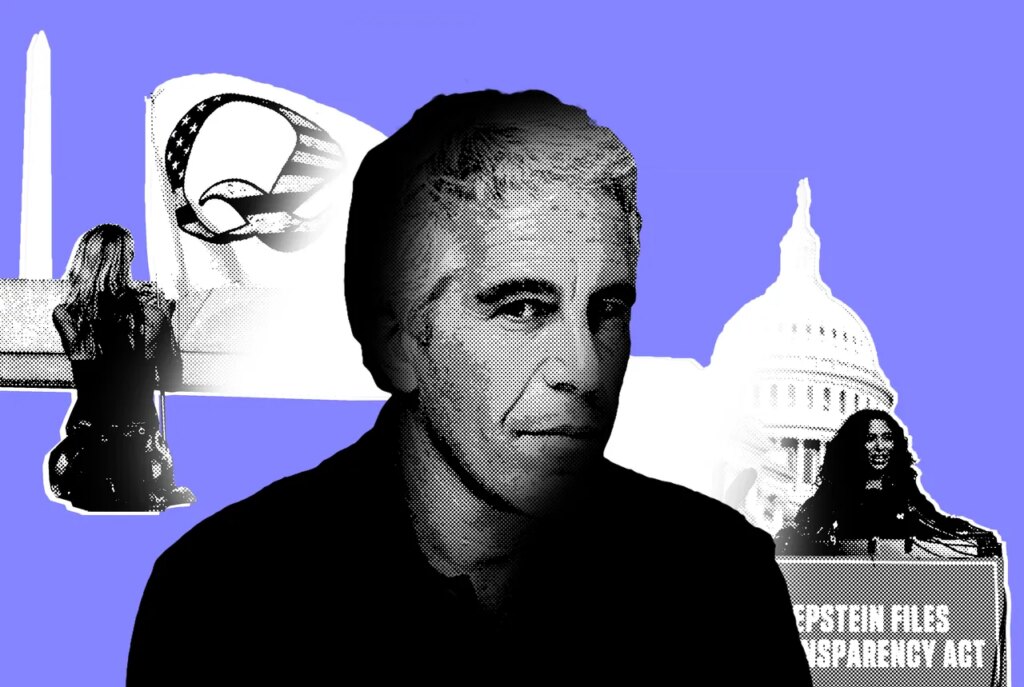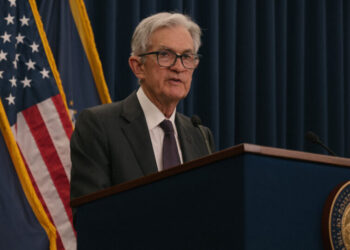For almost a decade, President Donald Trump has managed to control the conspiracy theory spin around disgraced financier and registered sex offender Jeffrey Epstein. The conspiracy theories benefited him; they were one of the factors buoying him to office. It’s only been in the last few weeks—spurred by the release of new Epstein documents and the public defection of GOP lawamkers—that the complex web of misinformation has spun out of Trump’s control.
It all began with QAnon. It is hard to overstate just how fringe QAnon was when Georgia representative Marjorie Taylor Greene began posting about it in November 2017, when she posted a video praising Q as a “patriot.”
The movement was led by “Q,” someone who claimed to be a government insider and who posted what they claimed was top secret intel in posts, known as “drops,” on the anonymous message board 4chan. Q laid out a wild and untrue conspiracy theory that a cabal of Democrat and Hollywood elites were behind a supposed global sex trafficking ring.
Already, Jeffrey Epstein was among the key characters in the QAnon universe.
Epstein was first mentioned just two weeks after QAnon began in late October 2017 and was referenced dozens of times in the almost 5,000 posts Q wrote over the following three years. Like all good conspiracy theories, this one contained a kernel of truth: The fact that Epstein had pleaded guilty in 2008 to state prostitution solicitation charges meant QAnon supporters felt emboldened to believe every wild allegation that Q put forward.
I became aware of QAnon in early 2018 but didn’t write about it until September of that year. At the time Greene started promoting it, years before she was elected to Congress, the conspiracy was in its infancy with just a handful of dedicated followers.
Trump was quickly cast as the hero of this narrative, working against the “deep state” to expose these demons and bring about “the storm,” which would see the cabal unmasked and everyone from Epstein to the Clintons face public executions. (No, really.) Trump, who has claimed his relationship with Epstein ended around 2004, used the QAnon community to his benefit. Trump famously praised its followers ahead of the 2020 election, and supported Greene’s congressional campaign after she won her primary.
Epstein had become a sort of shorthand for those within QAnon trying to explain it to outsiders. Q repeatedly returned to the topic of Epstein, claiming the disgraced financier had a “dungeon (beneath the temple)” on his island along with “sex & torture rooms.”
The QAnon community became convinced that Trump was about to expose the cabal. (Q and their followers conveniently overlooked the fact that Trump was president at the time, and theoretically could have exposed anyone he wanted.)
When Epstein was arrested and charged in July 2019 with sex trafficking of minors, QAnon celebrated, believing the “storm” had finally arrived. But Q urged caution in multiple posts, hinting that something bad was about to happen. When Epstein was found dead in his Manhattan jail cell the following month, many felt Q was vindicated. Others, now programmed to trust nothing, believed Epstein was still alive, rescued by the cabal to prevent their identities being unmasked.
After Trump won reelection in 2024—running in part on the suggestion that he would release the Epstein files—he continued catering to his conspiratorial base. On his Truth Social platform, he has amplified QAnon content almost 1,000 times. And it wasn’t just QAnon anymore; the Epstein conspiracy theories had escaped containment, as major figures within the Trump movement pushed QAnon conspiracies without the QAnon branding. Central to that has been the repeated drumbeat of calls to release the Epstein files. Among the loudest voices on the right calling for this were Kash Patel and Dan Bongino, two former right-wing social media influencers who Trump installed as director and deputy director of the FBI.
Despite early signs that QAnon followers’ fever dreams would be fulfilled, it soon became clear that Trump was reneging on his promise. In February, attorney general Pam Bondi said the Epstein client list was “sitting” on her desk. Binders of Epstein files were handed out to right-wing influencers. But in July, the FBI and the Department of Justice concluded there was no client list and that any investigation was essentially closed, sparking an enormous backlash among his supporters.
Last week, after the Committee on House Oversight and Government Reform released a trove of 20,000 documents, the situation got even murkier. Trump’s relationship with Epstein was alleged to be more complex than the president has made out. (“Of course he knew about the girls,” Epstein claimed in one email about Trump. In other messages first reported by WIRED, Epstein claimed intimate knowledge of Trump’s views in 2017, more than a decade after Trump claims he last talked to the sex offender.)
Despite the revelations, most of MAGA reacted with barely a shrug, repeating Trump’s line that this was all a hoax. In QAnon world, they claimed the documents actually show Trump was acting as an informant for the FBI against Epstein.
But some on the right, including antisemitic influencer Nick Fuentes and right-wing podcaster Candace Owens, haven’t been able to let it go. They’ve slammed Trump for breaking his promises on Epstein. And Greene, once his staunchest ally in Congress, appears angrier than anyone.
“It’s astonishing really how hard he’s fighting to stop the Epstein files from coming out that he actually goes to this level,” Greene wrote on X on Friday, referencing Trump’s attempts to coerce GOP lawmakers to vote against a bill that would force the release of the files. It’s been almost eight years to the day since Greene posted her first video about Q.
Trump lashed out at Greene, calling her a “traitor.” But on Sunday evening, appearing to realize that he was no longer in control of the narrative around Epstein, Trump reversed course and said Republican lawmakers should vote in favor of releasing the files. Of course, Trump doesn’t need Congress to vote on releasing the files, he could do it immediately, and could have done at any point since his inauguration in January.
On Tuesday, the House voted overwhelmingly to support a bill that will force the release of the Epstein files. It quickly passed the Senate as well, and now just awaits Donald Trump’s signature.
Trump continues to claim the files contain nothing damning for him, and that it’s all a Democrat-orchestrated hoax. He has directed the DOJ to investigate alleged links between Epstein and former president Bill Clinton in what appears to be a final desperate attempt to guide the narrative.
But as the last few weeks have shown, at the end of the day, Trump might no longer be in control.
This is an edition of the Inner Loop newsletter. Read previous newsletters here.
The post How Donald Trump Lost Control of the Epstein Spin Cycle appeared first on Wired.




